Spatiotemporal Evolution and Trend Prediction of Tourism Economic Vulnerability in China’s Major Tourist Cities
Abstract
:1. Introduction
2. Materials and Methods
2.1. Study Area
2.2. Research Framework
2.3. Index System Construction
2.4. Data Sources
2.5. Research Methods
2.5.1. The Weights of Indicators Were Calculated by the Entropy Weight Method
- (1)
- Set the original evaluation matrix as:
- (2)
- Standardize the above original evaluation matrix to form a standardized matrix:where represents the standardized value of the -th indicator in the -th sample. Among them, the positive indicators are , and the negative indicators are .
- (3)
- Use the entropy weight method to obtain the weights of indicators. The specific calculation formula is as follows:
2.5.2. TOPSIS Model Was Used to Calculate the Values of Sensitivity, Adaptive Capacity, and TEV
- (1)
- Construct the weighting matrix:where is the matrix obtained after standardized processing in the entropy weight method mentioned above, and is the weight of indicator .
- (2)
- Determine the optimal solution and the worst solution for the -th indicator:
- (3)
- Calculate the Euclidean distance between the optimal (inferior) solution and the positive (negative) ideal solution. is the sample reference, and is the indicator reference:
- (4)
- Calculate the proximity Ci:
2.5.3. The Main Factors Affecting TEV Were Detected by the Obstacle Diagnosis Model
2.5.4. The Evolution Trends of TEV Were Predicted by the BP Neural Network Model
- (1)
- Model setting
- (2)
- Model building
- (3)
- Initial data processing and parameter setting
- (4)
- Model training and testing
3. Results
3.1. Spatiotemporal Evolution of Urban TEV
3.1.1. The Evaluation of Each Indicator Weight in Urban TEV
3.1.2. Spatiotemporal Changes of Urban TEV
3.2. Obstacle Factor Diagnosis of TEV
3.3. Prediction of the Evolution Trend of Urban TEV in the Next 10 Years
4. Discussion
4.1. Internal Logic of Spatiotemporal Evolution of TEV
4.2. Obstacle Factors Affecting TEV
4.3. Trend Prediction of TEV
5. Conclusions
Author Contributions
Funding
Institutional Review Board Statement
Informed Consent Statement
Data Availability Statement
Conflicts of Interest
Appendix A
| City | Data Source | City | Data Source |
|---|---|---|---|
| Beihai | CCSY 2005–2020; Beihai SY 2005–2020; Beihai SCNESD 2004–2019; YCTS 2005–2018 | Qingdao | CCSY 2005–2020; Qingdao SY 2005–2020; Qingdao SCNESD 2004–2019; YCTS 2005–2018 |
| Beijing | CCSY 2005–2020; Beijing SY 2005–2020; Beijing SCNESD 2004–2019; YCTS 2005–2018 | Quanzhou | CCSY 2005–2020; Quanzhou SY 2005–2020; Quanzhou SCNESD 2004–2019; YCTS 2005–2018 |
| Chengdu | CCSY 2005–2020; Chengdu SY 2005–2020; Chengdu SCNESD 2004–2019; YCTS 2005–2018 | Sanya | CCSY 2005–2020; Sanya SY 2005–2020; Sanya SCNESD 2004–2019; YCTS 2005–2018 |
| Chengde | CCSY 2005–2020; Chengde SY 2005–2020; Chengde SCNESD 2004–2019; YCTS 2005–2018 | Xiamen | CCSY 2005–2020; Xiamen SY 2005–2020; Xiamen SCNESD 2004–2019; YCTS 2005–2018 |
| Dalian | CCSY 2005–2020; Dalian SY 2005–2020; Dalian SCNESD 2004–2019; YCTS 2005–2018 | Shantou | CCSY 2005–2020; Shantou SY 2005–2020; Shantou SCNESD 2004–2019; YCTS 2005–2018 |
| Datong | CCSY 2005–2020; Datong SY 2005–2020; Datong SCNESD 2004–2019; YCTS 2005–2018 | Shanghai | CCSY 2005–2020; Shanghai SY 2005–2020; Shanghai SCNESD 2004–2019; YCTS 2005–2018 |
| Fuzhou | CCSY 2005–2020; Fuzhou SY 2005–2020; Fuzhou SCNESD 2004–2019; YCTS 2005–2018 | Shenyang | CCSY 2005–2020; Shenyang SY 2005–2020; Shenyang SCNESD 2004–2019; YCTS 2005–2018 |
| Guangzhou | CCSY 2005–2020; Guangzhou SY 2005–2020; Guangzhou SCNESD 2004–2019; YCTS 2005–2018 | Shenzhen | CCSY 2005–2020; Shenzhen SY 2005–2020; Shenzhen SCNESD 2004–2019; YCTS 2005–2018 |
| Guiyang | CCSY 2005–2020; Guiyang SY 2005–2020; Guiyang SCNESD 2004–2019; YCTS 2005–2018 | Shijiazhuang | CCSY 2005–2020; Shijiazhuang SY 2005–2020; Shijiazhuang SCNESD 2004–2019; YCTS 2005–2018 |
| Guilin | CCSY 2005–2020; Guilin SY 2005–2020; Guilin SCNESD 2004–2019; YCTS 2005–2018 | Suzhou | CCSY 2005–2020; Suzhou SY 2005–2020; Suzhou SCNESD 2004–2019; YCTS 2005–2018 |
| Harbin | CCSY 2005–2020; Harbin SY 2005–2020; Harbin SCNESD 2004–2019; YCTS 2005–2018 | Taiyuan | CCSY 2005–2020; Taiyuan SY 2005–2020; Taiyuan SCNESD 2004–2019; YCTS 2005–2018 |
| Haikou | CCSY 2005–2020; Haikou SY 2005–2020; Haikou SCNESD 2004–2019; YCTS 2005–2018 | Tianjin | CCSY 2005–2020; Tianjin SY 2005–2020; Tianjin SCNESD 2004–2019; YCTS 2005–2018 |
| Hangzhou | CCSY 2005–2020; Hangzhou SY 2005–2020; Hangzhou SCNESD 2004–2019; YCTS 2005–2018 | Weihai | CCSY 2005–2020; Weihai SY 2005–2020; Weihai SCNESD 2004–2019; YCTS 2005–2018 |
| Hefei | CCSY 2005–2020; Hefei SY 2005–2020; Hefei SCNESD 2004–2019; YCTS 2005–2018 | Wenzhou | CCSY 2005–2020; Wenzhou SY 2005–2020; Wenzhou SCNESD 2004–2019; YCTS 2005–2018 |
| Hohhot | CCSY 2005–2020; Hohhot SY 2005–2020; Hohhot SCNESD 2004–2019; YCTS 2005–2018 | Urumqi | CCSY 2005–2020; Urumqi SY 2005–2020; Urumqi SCNESD 2004–2019; YCTS 2005–2018 |
| Huangshan | CCSY 2005–2020; Huangshan SY 2005–2020; Huangshan SCNESD 2004–2019; YCTS 2005–2018 | Wuxi | CCSY 2005–2020; Wuxi SY 2005–2020; Wuxi SCNESD 2004–2019; YCTS 2005–2018 |
| Jilin | CCSY 2005–2020; Jilin SY 2005–2020; Jilin SCNESD 2004–2019; YCTS 2005–2018 | Wuhan | CCSY 2005–2020; Wuhan SY 2005–2020; Wuhan SCNESD 2004–2019; YCTS 2005–2018 |
| Jinan | CCSY 2005–2020; Jinan SY 2005–2020; Jinan SCNESD 2004–2019; YCTS 2005–2018 | Xi’an | CCSY 2005–2020; Xi’an SY 2005–2020; Xi’an SCNESD 2004–2019; YCTS 2005–2018 |
| Jiujiang | CCSY 2005–2020; Jiujiang SY 2005–2020; Jiujiang SCNESD 2004–2019; YCTS 2005–2018 | Xining | CCSY 2005–2020; Xining SY 2005–2020; Xining SCNESD 2004–2019; YCTS 2005–2018 |
| Kunming | CCSY 2005–2020; Kunming SY 2005–2020; Kunming SCNESD 2004–2019; YCTS 2005–2018 | Yantai | CCSY 2005–2020; Yantai SY 2005–2020; Yantai SCNESD 2004–2019; YCTS 2005–2018 |
| Lanzhou | CCSY 2005–2020; Lanzhou SY 2005–2020; Lanzhou SCNESD 2004–2019; YCTS 2005–2018 | Yinchuan | CCSY 2005–2020; Yinchuan SY 2005–2020; Yinchuan SCNESD 2004–2019; YCTS 2005–2018 |
| Lianyungang | CCSY 2005–2020; Lianyungang SY 2005–2020; Lianyungang SCNESD 2004–2019; YCTS 2005–2018 | Zhanjiang | CCSY 2005–2020; Zhanjiang SY 2005–2020; Zhanjiang SCNESD 2004–2019; YCTS 2005–2018 |
| Luoyang | CCSY 2005–2020; Luoyang SY 2005–2020; Luoyang SCNESD 2004–2019; YCTS 2005–2018 | Zhangzhou | CCSY 2005–2020; Zhangzhou SY 2005–2020; Zhangzhou SCNESD 2004–2019; YCTS 2005–2018 |
| Nanchang | CCSY 2005–2020; Nanchang SY 2005–2020; Nanchang SCNESD 2004–2019; YCTS 2005–2018 | Changchun | CCSY 2005–2020; Changchun SY 2005–2020; Changchun SCNESD 2004–2019; YCTS 2005–2018 |
| Nanjing | CCSY 2005–2020; Nanjing SY 2005–2020; Nanjing SCNESD 2004–2019; YCTS 2005–2018 | Changsha | CCSY 2005–2020; Changsha SY 2005–2020; Changsha SCNESD 2004–2019; YCTS 2005–2018 |
| Nanning | CCSY 2005–2020; Nanning SY 2005–2020; Nanning SCNESD 2004–2019; YCTS 2005–2018 | Zhengzhou | CCSY 2005–2020; Zhengzhou SY 2005–2020; Zhengzhou SCNESD 2004–2019; YCTS 2005–2018 |
| Nantong | CCSY 2005–2020; Nantong SY 2005–2020; Nantong SCNESD 2004–2019; YCTS 2005–2018 | zhongshan | CCSY 2005–2020; zhongshan SY 2005–2020; zhongshan SCNESD 2004–2019; YCTS 2005–2018 |
| Ningbo | CCSY 2005–2020; Ningbo SY 2005–2020; Ningbo SCNESD 2004–2019; YCTS 2005–2018 | Chongqing | CCSY 2005–2020; Chongqing SY 2005–2020; Chongqing SCNESD 2004–2019; YCTS 2005–2018 |
| Qinhuangdao | CCSY 2005–2020; Qinhuangdao SY 2005–2020; Qinhuangdao SCNESD 2004–2019; YCTS 2005–2018 | Zhuhai | CCSY 2005–2020; Zhuhai SY 2005–2020; Zhuhai SCNESD 2004–2019; YCTS 2005–2018 |
References
- Timmerman, P. Vulnerability, Resilience and the Collapse of Socieiy: A Review of Models and Possible Climatic Applications; Institute for Environmental Studies Toronto, Universisty of Toronto: Toronto, ON, Canada, 1981. [Google Scholar]
- Yamano, H.; Kayanne, H.; Yamaguchi, T.; Kuwahara, Y.; Yokoki, H.; Shimazaki, H.; Chikamori, M. Atoll island vulnerability to flooding and inundation revealed by historical reconstruction: Fongafale Islet, Funafuti Atoll, Tuvalu. Glob. Planet. Chang. 2007, 57, 407–416. [Google Scholar] [CrossRef]
- Toni, F.; Holanda, E. The effects of land tenure on vulnerability to droughts in Northeastern Brazil. Glob. Environ. Chang. 2008, 18, 575–582. [Google Scholar] [CrossRef]
- Wilson, K.; Newton, A.; Echeverría, C.; Weston, C.; Burgman, M. A vulnerability analysis of the temperate forests of south central Chile. Biol. Conserv. 2005, 122, 9–21. [Google Scholar] [CrossRef]
- Ho, H.C.; Knudby, A.; Chi, G. Spatiotemporal analysis of regional socio-economic vulnerability change associated with heat risks in Canada. Appl. Geogr. 2018, 95, 61–70. [Google Scholar] [CrossRef] [PubMed]
- Liu, W.; Li, L.; Chen, L.; Wen, M.; Wang, J.; Yuan, L.; Liu, Y.; Li, H. Testing a comprehensive volcanic risk assessment of tenerife by volcanic hazard simulations and social vulnerability analysis. ISPRS Int. Geo-Inf. 2020, 9, 273. [Google Scholar] [CrossRef]
- Susan, L.; Cutter, B.J.; Boruff, W.; Lynn, S. Social vulnerability to environmental hazards. Soc. Sci. Q. 2003, 84, 242–261. [Google Scholar] [CrossRef]
- Adrianto, L.; Matsuda, Y. Developing economic vulnerability indices of environmental disasters in small island regions. Environ. Impact Assess. Rev. 2002, 22, 393–414. [Google Scholar] [CrossRef]
- Wim, N.; Amelia, S.-P.; Mark, M. Measuring vulnerability: An overview and introduction. Oxf. Dev. Stud. 2009, 37, 183–191. [Google Scholar] [CrossRef]
- Altimari, A.; Balzano, S.; Zezza, G. Measuring economic vulnerability: A structural equation modeling approach. In Statistical Learning of Complex Data; Greselin, F., Deldossi, L., Bagnato, L., Vichi, M., Eds.; Springer: Cham, Switzerland, 2019; pp. 95–102. [Google Scholar]
- Briguglio, L. Small island developing states and their economic vulnerabilities. World Dev. 1995, 23, 1615–1632. [Google Scholar] [CrossRef]
- Briguglio, L.; Cordina, G.; Farrugia, N. Economic vulnerability and resilience: Concepts and measurements. Oxf. Dev. Stud. 2009, 37, 229–247. [Google Scholar] [CrossRef]
- Chan, V.K.Y. The Impact of the Global Financial Crisis on the Entertainment Tourism Industry: A Financial Engineering Case Study of Macao from 2007 to 2010. Syst. Eng. Procedia 2011, 1, 323–329. [Google Scholar] [CrossRef] [Green Version]
- Zhou, B.; Zhang, Y.; Zhou, P. Multilateral political effects on outbound tourism. Ann. Touris. Res. 2021, 88, 103184. [Google Scholar] [CrossRef]
- Kılıçlar, A.; Uşaklı, A.; Tayfun, A. Terrorism prevention in tourism destinations: Security forces vs. civil authority perspectives. J. Destin. Mark. Manag. 2018, 8, 232–246. [Google Scholar] [CrossRef]
- Altuntas, F.; Gok, M.S. The effect of COVID-19 pandemic on domestic tourism: A DEMATEL method analysis on quarantine decisions. Int. J. Hosp. Manag. 2021, 92, 102719. [Google Scholar] [CrossRef]
- Rosselló, J.; Becken, S.; Santana-Gallego, M. The effects of natural disasters on international tourism: A global analysis. Tour. Manag. 2020, 79, 104080. [Google Scholar] [CrossRef]
- Croes, R.; Ridderstaat, J.; Bak, M.; Zientara, P. Tourism specialization, economic growth, human development and transition economies: The case of Poland. Tour. Manag. 2021, 82, 104181. [Google Scholar] [CrossRef]
- Wang, Z.D. Dynamic relationship between tourism, economic growth, and environmental quality. J. Sustain. Tour. 2018, 26, 1928–1943. [Google Scholar] [CrossRef]
- Canh, N.P.; Thanh, S.D. Domestic tourism spending and economic vulnerability. Ann. Tour. Res. 2020, 85, 103063. [Google Scholar] [CrossRef]
- Su, F.; Chen, Y.; Zhang, P. Vulnerability assessment of tourism city’s economic system based on the set pair analysis: A case study of Zhoushan city. Sci. Geogr. Sin. 2013, 33, 538–544. (In Chinese) [Google Scholar]
- Li, F. The frangibility of tourism economy: Definition, formation mechanism and frame analysis. East China Econ. Manag. 2013, 27, 76–81. (In Chinese) [Google Scholar]
- Ma, H.Q.; Lian, Q.W.; Lun, Y.C. Spatial differentiation of tourism economic system vulnerability based on BP neural network in different provinces of China. Res. Sci. 2019, 41, 2248–2261. (In Chinese) [Google Scholar] [CrossRef]
- Huang, L.; Yin, X.; Yang, Y.; Luo, M.; Huang, S. “Blessing in disguise”: The impact of the Wenchuan earthquake on inbound tourist arrivals in Sichuan, China. J. Hosp. Tour. Manag. 2020, 42, 58–66. [Google Scholar] [CrossRef]
- Pham, T.D.; Dwyer, L.; Su, J.-J.; Ngo, T. COVID-19 impacts of inbound tourism on Australian economy. Ann. Tour. Res. 2021, 88, 103179. [Google Scholar] [CrossRef]
- Backer, E.; Ritchie, B. VFR Travel: A viable market for tourism crisis and disaster recovery? Int. J. Tour. Res. 2017, 19, 400–411. [Google Scholar] [CrossRef]
- Gurtner, Y. Returning to paradise: Investigating issues of tourism crisis and disaster recovery on the island of Bali. J. Hosp. Tour. Manag. 2016, 28, 11–19. [Google Scholar] [CrossRef]
- Raki, A.; Nayer, D.; Nazifi, A.; Alexander, M.; Seyfi, S. Tourism recovery strategies during major crises: The role of proactivity. Ann. Tour. Res. 2021, 103144. [Google Scholar] [CrossRef]
- Moghal, Z.; O’Connell, E. Multiple stressors impacting a small island tourism destination-community: A nested vulnerability assessment of Oistins, Barbados. Tour. Manag. Perspect. 2018, 26, 78–88. [Google Scholar] [CrossRef]
- Yin, P.; Liu, S.; Duan, P. Analysis on the vulnerability and obstacle indicators in island-type tourism destination—Take Zhoushan city for example. Ecol. Geogr. 2017, 37, 234–240. (In Chinese) [Google Scholar]
- Jia, Y.; Hu, J.; Xie, S.; Qiao, H.; Liu, D. Vulnerability and influence mechanisms of social-ecological system in poor mountainous tourism destinations. Hum. Geogr. 2021, 36, 155–164. (In Chinese) [Google Scholar]
- Liang, Z.; Xie, L. On the vulnerability of economic system of traditional tourism cities—A case from Guilin. Tour. Trib. 2011, 26, 40–46. (In Chinese) [Google Scholar]
- Yang, Y.; Wang, R. Research on vulnerability assessment of tourism economic system and the path optimization in border ethnic Region: A case study of Korean autonomous prefecture of Yanbian. Areal Res. Dev. 2015, 34, 104–109. (In Chinese) [Google Scholar]
- Huang, C.; Lin, F.; Chu, D.; Wang, L.; Liao, J.; Wu, J. Coupling relationship and interactive response between intensive land use and tourism industry development in China’s major tourist cities. Land 2021, 10, 697. [Google Scholar] [CrossRef]
- Polsky, C.; Neff, R.; Yarnal, B. Building comparable global change vulnerability assessments: The vulnerability scoping diagram. Glob. Environ. Chang. 2007, 17, 472–485. [Google Scholar] [CrossRef]
- Su, F.; Chu, Y.; Zhang, P. Analysis of economic vulnerability and obstacle factors of typical tourism cities in China. Ecol. Geogr. 2013, 33, 189–194. (In Chinese) [Google Scholar]
- Tian, L.; Tian, Y.; Yang, Y. Study on tourism economic system’s vulnerability assessment of Dali Prefecture based on TOPSIS. Res. Dev. Mark. 2017, 33, 1529–1534. (In Chinese) [Google Scholar]
- Chen, Y.; Zhu, M.; Lu, J.; Zhou, Q.; Ma, W. Evaluation of ecological city and analysis of obstacle factors under the background of high-quality development: Taking cities in the Yellow River Basin as examples. Ecol. Indic. 2020, 118, 106771. [Google Scholar] [CrossRef]
- Li, J.; Chen, Y.; Yao, X.; Chen, A. Risk management priority assessment of heritage sites in China based on entropy weight and TOPSIS. J. Cult. Herit. 2021, 49, 10–18. [Google Scholar] [CrossRef]
- Wang, D.; Shen, Y.; Zhao, Y.; He, W.; Liu, X.; Qian, X.; Lv, T. Integrated assessment and obstacle factor diagnosis of China’s scientific coal production capacity based on the PSR sustainability framework. Resour. Policy 2020, 68, 101794. [Google Scholar] [CrossRef]
- Li, S.; Wang, Y.; Hao, M.; Jiang, D.; Xun, Z.; Zhou, R. Site selection of digital signage in Beijing: A combination of machine learning and an empirical approach. ISPRS Int. Geo-Inf. 2020, 9, 217. [Google Scholar] [CrossRef] [Green Version]
- Wang, W.; Tang, R.; Li, C.; Liu, P.; Luo, L. A BP neural network model optimized by Mind Evolutionary Algorithm for predicting the ocean wave heights. Ocean Eng. 2018, 162, 98–107. [Google Scholar] [CrossRef]
- Broshi-Chen, O.; Mansfeld, Y. A wasted invitation to innovate? Creativity and innovation in tourism crisis management: A QC&IM approach. J. Hosp. Tour. Manag. 2021, 46, 272–283. [Google Scholar] [CrossRef]
- Gnangnon, S.K. Trade openness and structural vulnerability in developing countries. J. Ecol. Stud. 2016, 43, 70–89. [Google Scholar] [CrossRef]
- Deng, T.; Hu, Y.; Ma, M. Regional policy and tourism: A quasi-natural experiment. Ann. Tour. Res. 2019, 74, 1–16. [Google Scholar] [CrossRef]
- Wang, Y.-S. The impact of crisis events and macroeconomic activity on Taiwan’s international inbound tourism demand. Tour. Manag. 2009, 30, 75–82. [Google Scholar] [CrossRef]
- Hanon, W.; Wang, E. Comparing the impact of political instability and terrorism on inbound tourism demand in Syria before and after the political crisis in 2011. Asia Pac. J. Tour. Res. 2020, 25, 651–661. [Google Scholar] [CrossRef]
- Sun, G. Some responses to the doubt of whether tourism develops with certain rules. Tour. Sci. 2008, 22, 1–4. (In Chinese) [Google Scholar]
- Espiner, S.; Becken, S. Tourist towns on the edge: Conceptualising vulnerability and resilience in a protected area tourism system. J. Sustain. Tour. 2014, 22, 646–665. [Google Scholar] [CrossRef]
- Fei, J.; Lin, Y.; Jiang, Q.; Jiang, K.; Li, P.; Ye, G. Spatiotemporal coupling coordination measurement on islands’ economy-environment-tourism system. Ocean Coast. Manag. 2021, 212, 105793. [Google Scholar] [CrossRef]
- Tang, F.; Tao, W. Establish a composite system for sustainable tourism development. J. Dongbei Univ. Financ. Econ. 2001, 28–30. (In Chinese) [Google Scholar]
- Jia, Y.; Hu, J.; Liu, D. Spatial-temporal pattern of the coordinated development of ecology-culture-tour- ism of China’s provinces. World Reg. Stud. 2021, 30, 620–631. (In Chinese) [Google Scholar]
- Pan, D.; Shi, C. The forecasting method and application of the total retail sales of consumer goods in China. Stat. Decis. 2015, 96–98. (In Chinese) [Google Scholar]
- Demir, E.; Gozgor, G.; Paramati, S.R. To what extend economic uncertainty effects tourism investments? Evidence from OECD and non-OECD economies. Tour. Manag. Perspect. 2020, 36, 100758. [Google Scholar] [CrossRef]
- Zou, F.; Zou, D. A study on forecast of ecotourism demand in Hunan province based on the comparison of five models. Res. Environ. Yangtze Basin 2020, 29, 2406–2417. (In Chinese) [Google Scholar]
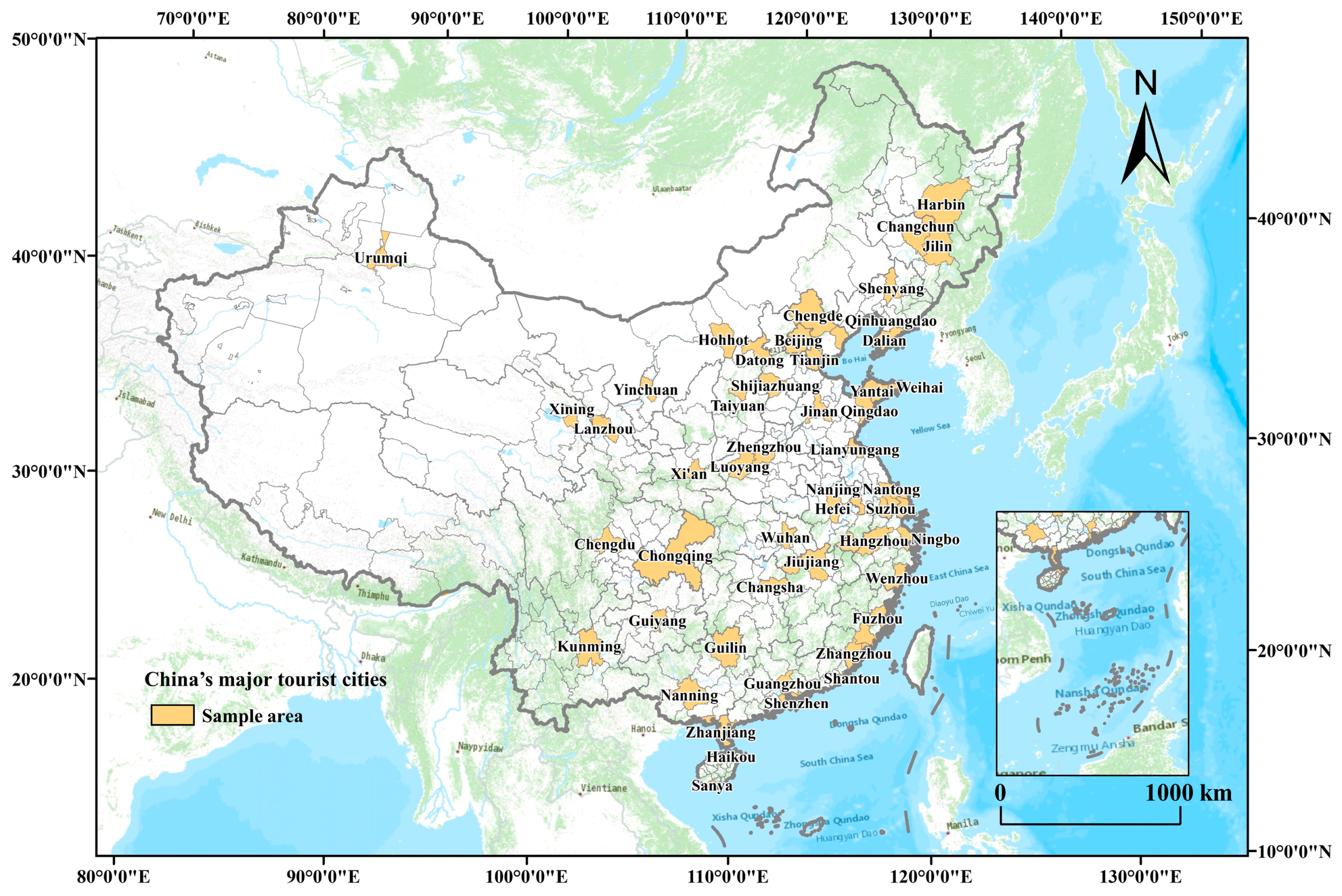
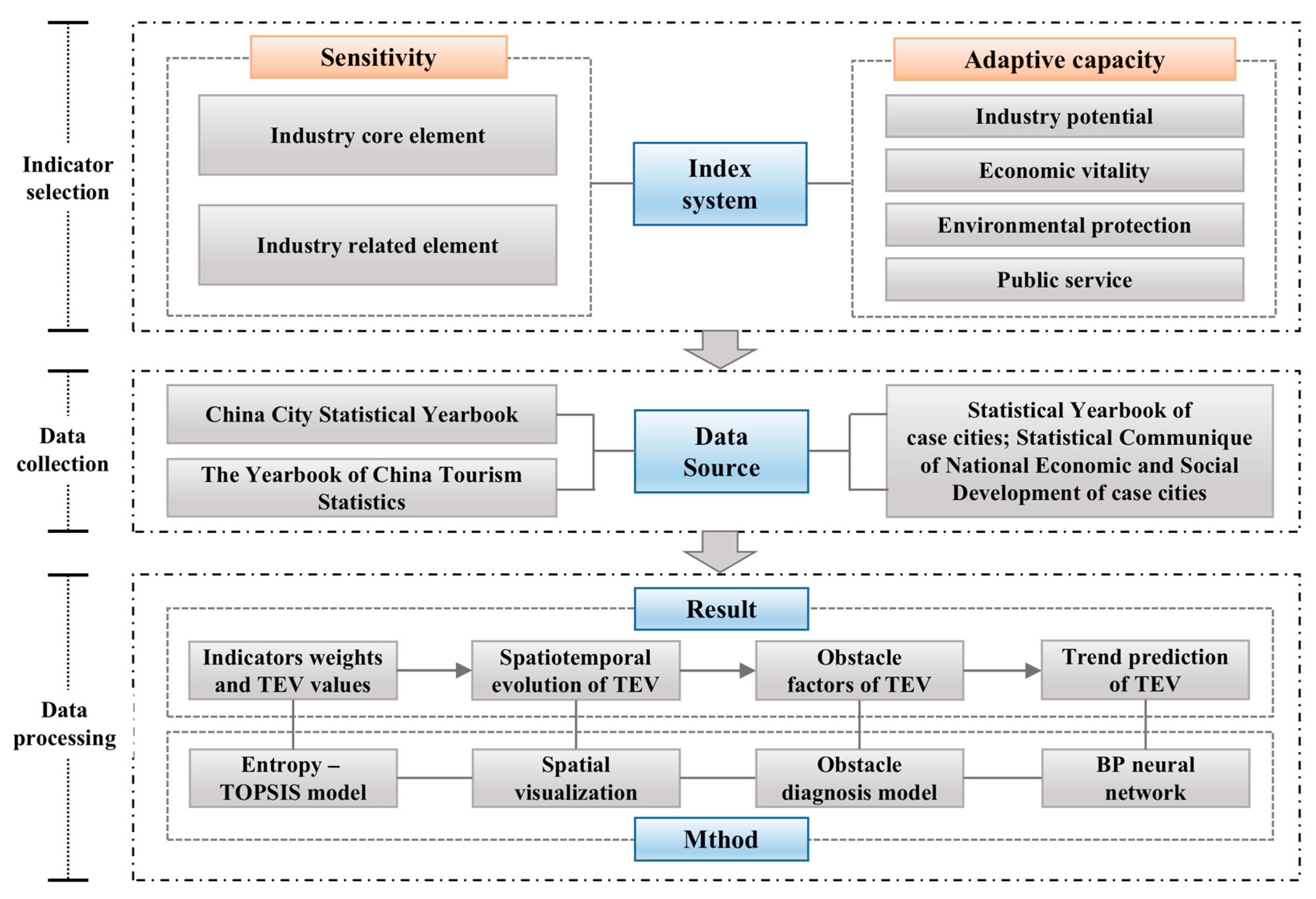

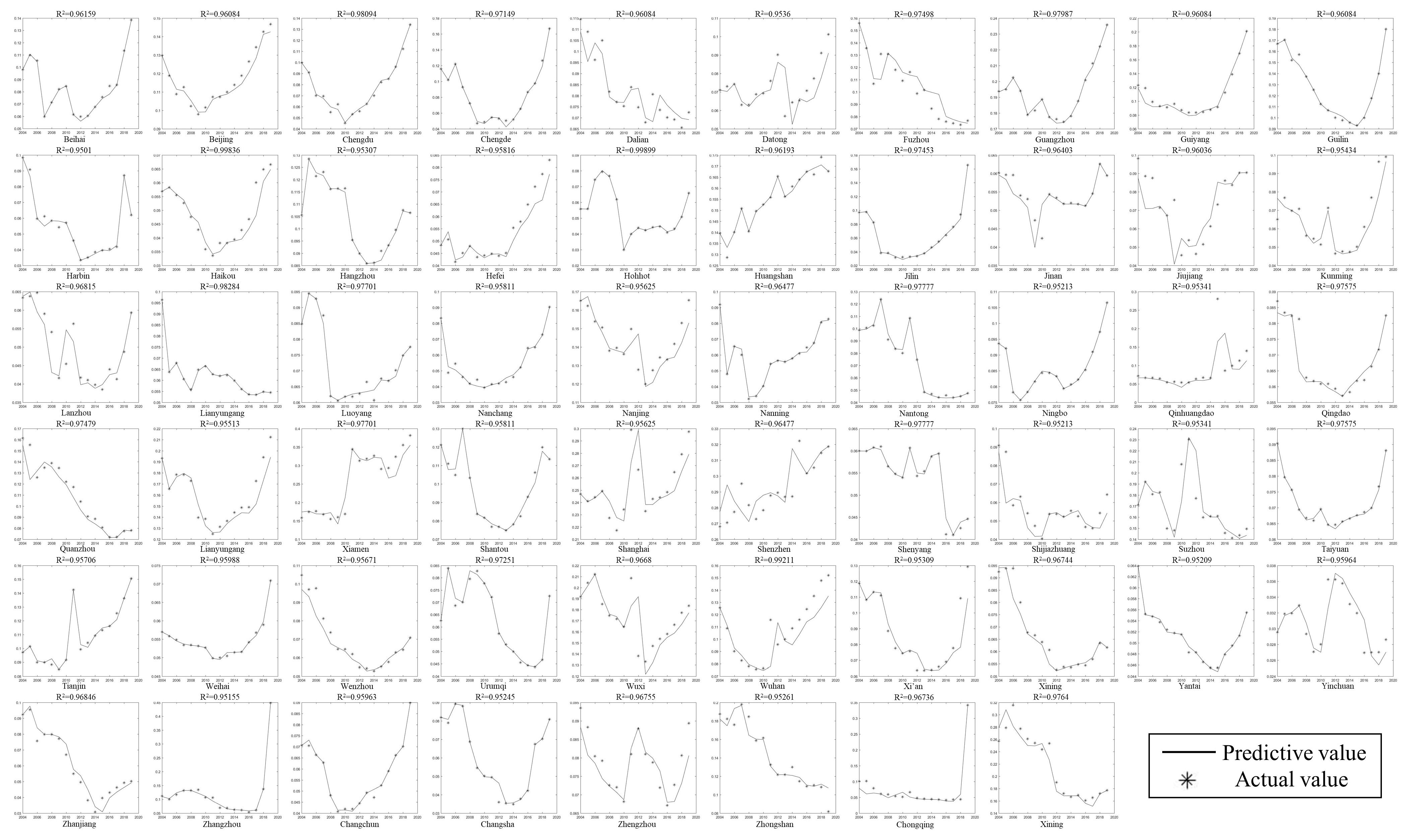
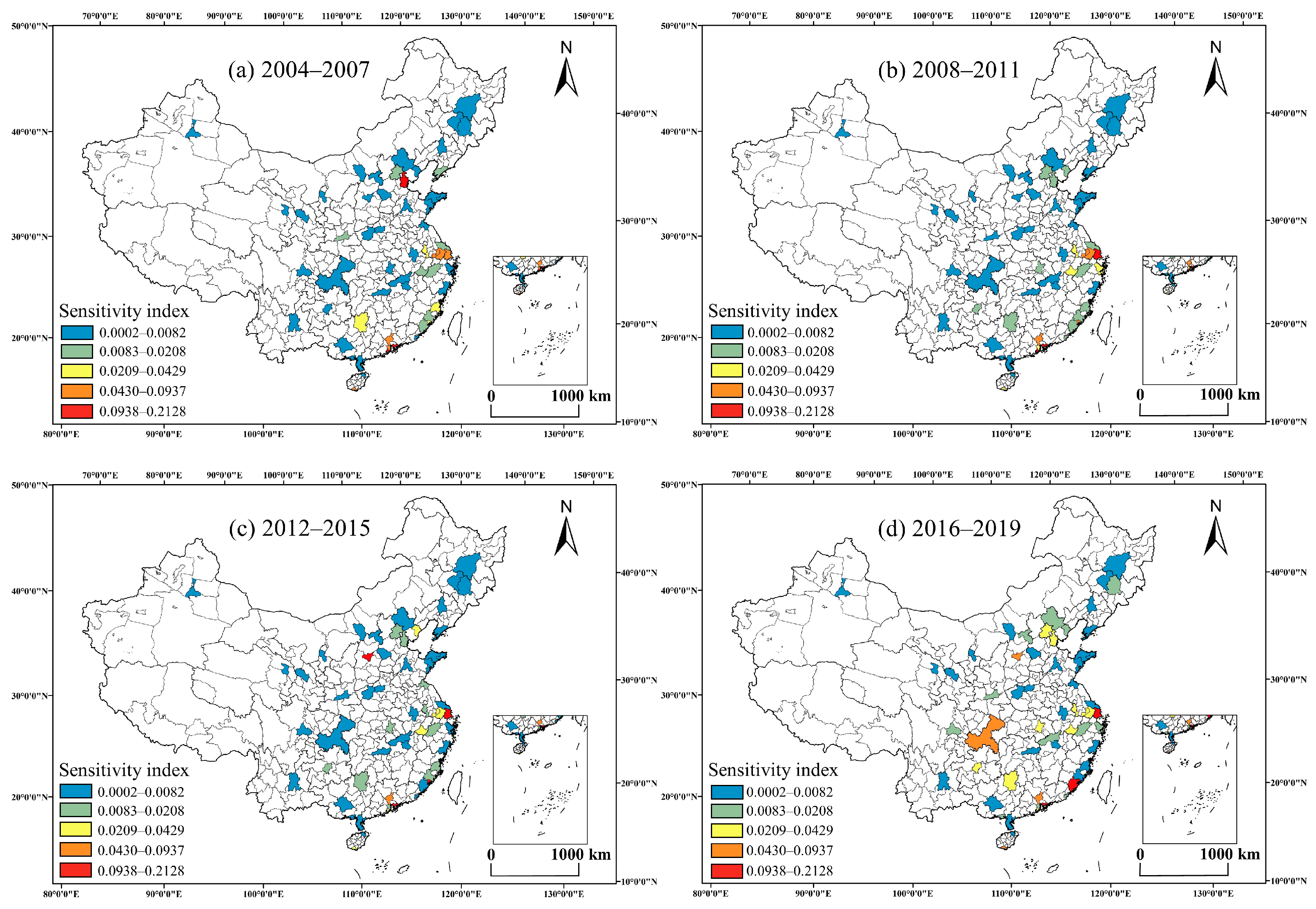
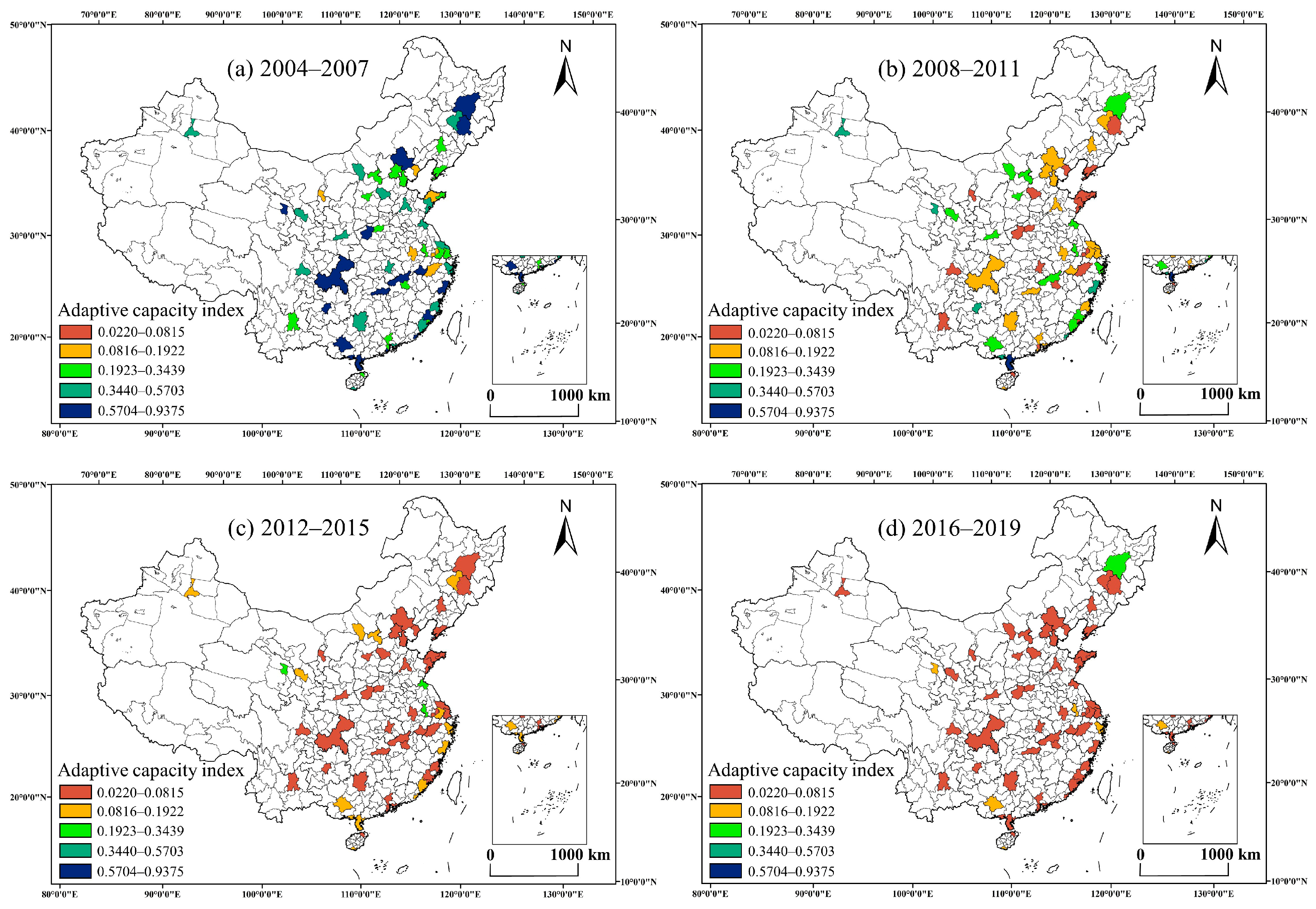
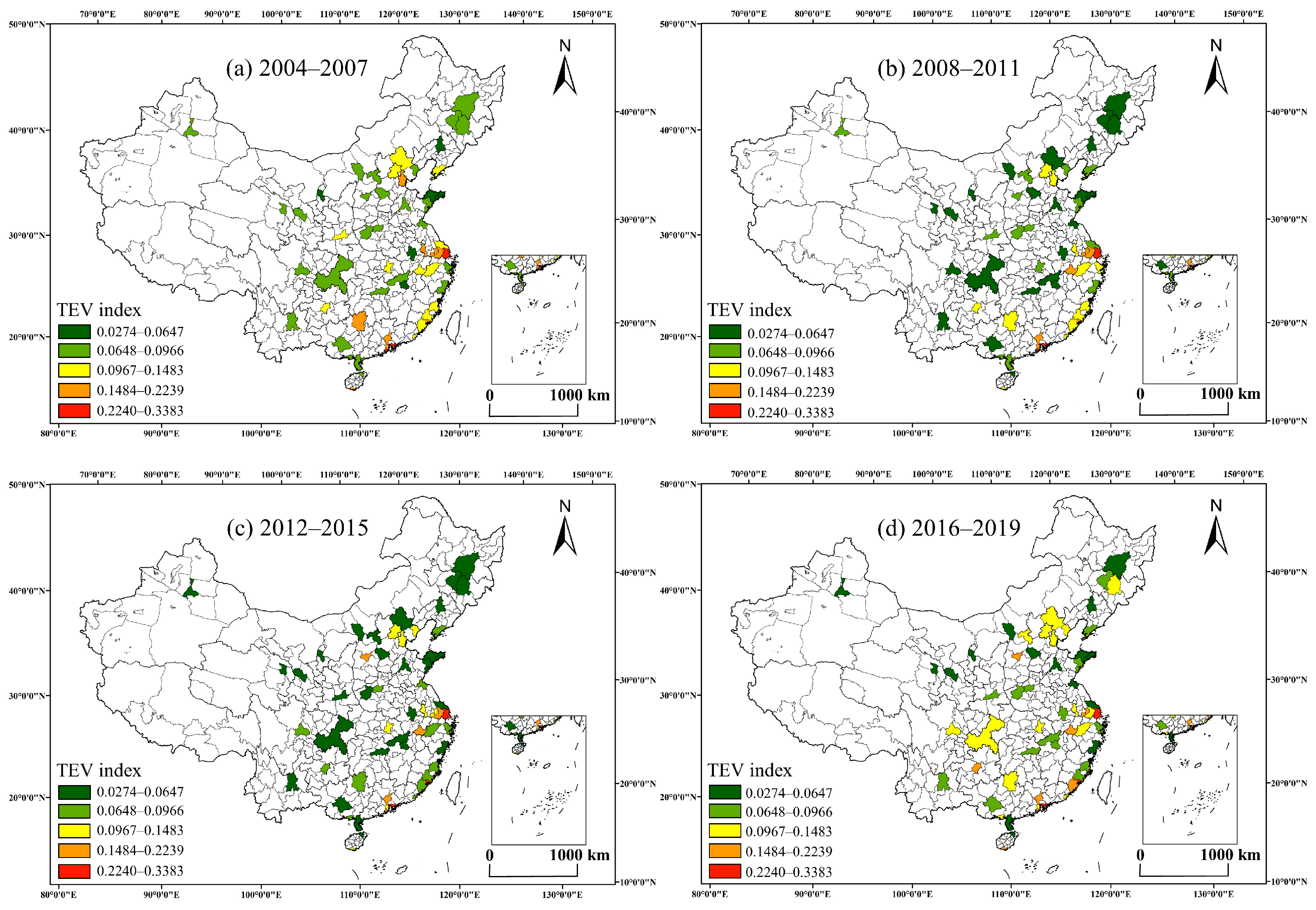
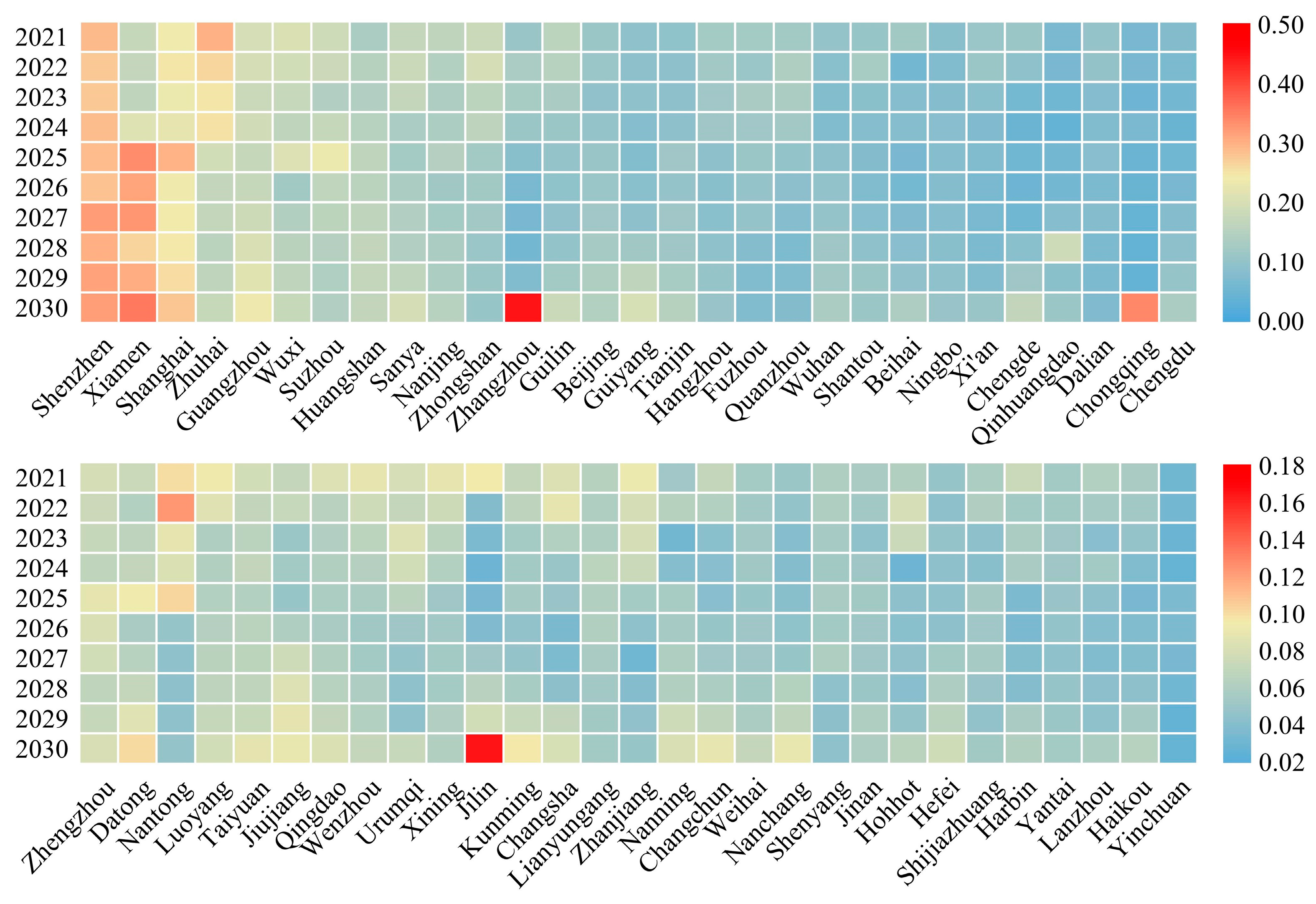
| System | Primary Indicator | Secondary Indicator | Unit | Attribute | Serial Number |
|---|---|---|---|---|---|
| Sensitivity | Industry core element | Proportion of total earnings from tourism in GDP | % | Positive | S1 |
| Elasticity coefficient of tourism to GDP growth | — | Positive | S2 | ||
| Proportion of international tourists out of total tourists | % | Positive | S3 | ||
| Proportion of tourism foreign exchange income in total tourism revenue | % | Positive | S4 | ||
| Proportion of total tourism revenue in tertiary industry output value | % | Positive | S5 | ||
| Tourism output density | 10,000 CNY/km2 | Positive | S6 | ||
| Industry-related element | Discharge of urban industrial wastewater per unit area | 10,000 tons/km2 | Positive | S7 | |
| Urban industrial sulfur dioxide emissions per unit area | ton/km2 | Positive | S8 | ||
| Urban industrial smoke and dust emission per unit area | ton/km2 | Positive | S9 | ||
| Urban registered unemployment rate | % | Positive | S10 | ||
| Adaptive capacity | Industry potential | Annual growth rate of total tourism income | % | Negative | A1 |
| Annual growth rate of total tourist arrivals | % | Negative | A2 | ||
| Economic vitality | GDP per capita | CNY | Negative | A3 | |
| GDP growth rate | % | Negative | A4 | ||
| Fixed asset investment per capita | 10,000 CNY | Negative | A5 | ||
| Per capita year-end deposit balance of financial institutions | CNY | Negative | A6 | ||
| Environmental protection | Green coverage rate in built-up areas | % | Negative | A7 | |
| Urban green space per capita | m2/person | Negative | A8 | ||
| Household harmless garbage disposal rate | % | Negative | A9 | ||
| Centralized sewage treatment rate | % | Negative | A10 | ||
| Public service | Per capita postal revenue | CNY | Negative | A11 | |
| The number of doctors per 10,000 people | Person | Negative | A12 | ||
| Per capita expenditure in local general public budgets | Yuan | Negative | A13 | ||
| Per capita paved road area at the end of the year | km2 | Negative | A14 | ||
| Number of buses per 10,000 people | Bus | Negative | A15 | ||
| Number of subscribers with broadband internet access | 10,000 households | Negative | A16 | ||
| Per capita revenue from telecommunications services | CNY | Negative | A17 |
| Serial Number | Weight | Serial Number | Weight | Serial Number | Weight |
|---|---|---|---|---|---|
| S1 | 0.0603 | S10 | 0.0580 | A9 | 0.0006 |
| S2 | 0.0006 | A1 | 0.0003 | A10 | 0.0411 |
| S3 | 0.1984 | A2 | 0.0002 | A11 | 0.0007 |
| S4 | 0.0868 | A3 | 0.0010 | A12 | 0.0036 |
| S5 | 0.0514 | A4 | 0.0045 | A13 | 0.0011 |
| S6 | 0.1340 | A5 | 0.0004 | A14 | 0.0013 |
| S7 | 0.1290 | A6 | 0.0010 | A15 | 0.0005 |
| S8 | 0.1043 | A7 | 0.0016 | A16 | 0.0003 |
| S9 | 0.1168 | A8 | 0.0014 | A17 | 0.0008 |
| City | Level 1 | Level 2 | Level 3 | Level 4 | Level 5 | City | Level 1 | Level 2 | Level 3 | Level 4 | Level 5 |
|---|---|---|---|---|---|---|---|---|---|---|---|
| Beihai | S3(0.2238) | S6(0.1445) | S9(0.1146) | S8(0.1137) | S7(0.1076) | Qingdao | S3(0.2215) | S6(0.1408) | S9(0.1159) | S8(0.1136) | S7(0.1065) |
| Beijing | S3(0.2295) | S6(0.1234) | S8(0.1216) | S9(0.1203) | S7(0.1117) | Quanzhou | S3(0.2255) | S6(0.1517) | S9(0.1191) | S8(0.1189) | S7(0.1046) |
| Chengdu | S3(0.2257) | S6(0.1369) | S8(0.1164) | S9(0.1161) | S7(0.1047) | Sanya | S3(0.2328) | S6(0.1455) | S8(0.1308) | S9(0.1259) | S7(0.1196) |
| Chengde | S3(0.2238) | S6(0.1528) | S8(0.1201) | S9(0.1171) | S7(0.1112) | Xiamen | S3(0.2370) | S9(0.1276) | S8(0.1107) | S6(0.0989) | S10(0.0720) |
| Dalian | S3(0.2268) | S6(0.1474) | S9(0.1185) | S8(0.1170) | S7(0.1006) | Shantou | S3(0.2208) | S6(0.1382) | S9(0.1155) | S8(0.1083) | S7(0.0965) |
| Datong | S3(0.2250) | S6(0.1508) | S9(0.1149) | S8(0.1132) | S7(0.1098) | Shanghai | S3(0.2528) | S9(0.1301) | S8(0.0989) | S6(0.0886) | S7(0.0850) |
| Fuzhou | S3(0.2229) | S6(0.1497) | S9(0.1171) | S8(0.1162) | S7(0.1106) | Shenyang | S3(0.2215) | S6(0.1445) | S9(0.1135) | S8(0.1134) | S7(0.1068) |
| Guangzhou | S3(0.2110) | S9(0.1288) | S8(0.1229) | S6(0.1228) | S7(0.1063) | Shenzhen | S3(0.1948) | S9(0.1362) | S8(0.1285) | S7(0.0987) | S6(0.0952) |
| Guiyang | S3(0.2304) | S6(0.1384) | S9(0.1177) | S7(0.1107) | S8(0.1097) | Shijiazhuang | S3(0.2250) | S6(0.1481) | S9(0.1143) | S8(0.1093) | S7(0.1034) |
| Guilin | S3(0.2220) | S6(0.1565) | S8(0.1245) | S9(0.1212) | S7(0.1148) | Suzhou | S3(0.2421) | S6(0.1422) | S9(0.1244) | S8(0.1053) | S4(0.0892) |
| Harbin | S3(0.2209) | S6(0.1484) | S8(0.1180) | S9(0.1141) | S7(0.1086) | Taiyuan | S3(0.1902) | S6(0.1477) | S9(0.1175) | S7(0.1116) | S8(0.1095) |
| Haikou | S3(0.2157) | S6(0.1400) | S8(0.1173) | S9(0.1133) | S7(0.1063) | Tianjin | S3(0.2183) | S6(0.1360) | S9(0.1217) | S8(0.1111) | S7(0.1082) |
| Hangzhou | S3(0.2344) | S6(0.1480) | S8(0.1243) | S9(0.1243) | S7(0.1002) | Weihai | S3(0.2182) | S6(0.1413) | S9(0.1135) | S8(0.1123) | S7(0.1063) |
| Hefei | S3(0.2204) | S6(0.1407) | S8(0.1154) | S9(0.1132) | S7(0.1060) | Wenzhou | S3(0.2223) | S6(0.1446) | S8(0.1162) | S9(0.1157) | S7(0.1065) |
| Hohhot | S3(0.2196) | S6(0.1468) | S8(0.1132) | S9(0.1130) | S7(0.1079) | Urumqi | S3(0.2163) | S6(0.1485) | S9(0.1139) | S8(0.1133) | S7(0.1079) |
| Huangshan | S3(0.2314) | S6(0.1583) | S8(0.1290) | S9(0.1245) | S7(0.1178) | Wuxi | S3(0.2338) | S6(0.1252) | S9(0.1161) | S8(0.1033) | S4(0.0957) |
| Jilin | S3(0.2242) | S6(0.1498) | S8(0.1183) | S9(0.1150) | S7(0.1078) | Wuhan | S3(0.2302) | S6(0.1303) | S9(0.1175) | S8(0.1122) | S7(0.1008) |
| Jinan | S3(0.2201) | S6(0.1405) | S9(0.1119) | S8(0.1103) | S7(0.1046) | Xi’an | S3(0.2258) | S6(0.1418) | S9(0.1174) | S8(0.1163) | S7(0.1068) |
| Jiujiang | S3(0.2248) | S6(0.1502) | S8(0.1174) | S9(0.1161) | S7(0.1087) | Xining | S3(0.2209) | S6(0.1475) | S9(0.1119) | S8(0.1101) | S7(0.1066) |
| Kunming | S3(0.2205) | S6(0.1468) | S9(0.1156) | S8(0.1153) | S7(0.1093) | Yantai | S3(0.2208) | S6(0.1449) | S9(0.1145) | S8(0.1127) | S7(0.1063) |
| Lanzhou | S3(0.2185) | S6(0.1460) | S8(0.1127) | S9(0.1124) | S7(0.1062) | Yinchuan | S3(0.2158) | S6(0.1452) | S9(0.1109) | S8(0.1104) | S7(0.1037) |
| Lianyungang | S3(0.2228) | S6(0.1463) | S8(0.1154) | S9(0.1144) | S7(0.1063) | Zhanjiang | S3(0.2186) | S6(0.1479) | S8(0.1160) | S9(0.1141) | S7(0.1066) |
| Luoyang | S3(0.2256) | S6(0.1476) | S9(0.1155) | S7(0.1091) | S8(0.1090) | Zhangzhou | S3(0.2170) | S6(0.1607) | S8(0.1276) | S9(0.1243) | S7(0.0928) |
| Nanchang | S3(0.2197) | S6(0.1414) | S8(0.1144) | S9(0.1127) | S7(0.1021) | Changchun | S3(0.2212) | S6(0.1451) | S8(0.1169) | S9(0.1138) | S7(0.1083) |
| Nanjing | S3(0.2353) | S6(0.1309) | S9(0.1195) | S8(0.1105) | S7(0.0910) | Changsha | S3(0.2199) | S6(0.1411) | S8(0.1161) | S9(0.1139) | S7(0.1072) |
| Nanning | S3(0.2234) | S6(0.1480) | S8(0.1182) | S9(0.1152) | S7(0.1075) | Zhengzhou | S3(0.2245) | S6(0.1372) | S9(0.1125) | S8(0.1052) | S7(0.1018) |
| Nantong | S3(0.2227) | S6(0.1473) | S9(0.1146) | S8(0.1121) | S7(0.1010) | Zhongshan | S3(0.2103) | S6(0.1413) | S9(0.1162) | S8(0.1085) | S7(0.0838) |
| Ningbo | S3(0.2278) | S6(0.1412) | S9(0.1183) | S7(0.1041) | S8(0.1034) | Chongqing | S3(0.2342) | S6(0.1650) | S9(0.1272) | S8(0.1252) | S7(0.1181) |
| Qinhuangdao | S3(0.2261) | S6(0.1479) | S8(0.1115) | S7(0.1084) | S9(0.1077) | Zhuhai | S3(0.1987) | S6(0.1454) | S9(0.1276) | S8(0.1150) | S7(0.1060) |
Publisher’s Note: MDPI stays neutral with regard to jurisdictional claims in published maps and institutional affiliations. |
© 2021 by the authors. Licensee MDPI, Basel, Switzerland. This article is an open access article distributed under the terms and conditions of the Creative Commons Attribution (CC BY) license (https://creativecommons.org/licenses/by/4.0/).
Share and Cite
Huang, C.; Lin, F.; Chu, D.; Wang, L.; Liao, J.; Wu, J. Spatiotemporal Evolution and Trend Prediction of Tourism Economic Vulnerability in China’s Major Tourist Cities. ISPRS Int. J. Geo-Inf. 2021, 10, 644. https://doi.org/10.3390/ijgi10100644
Huang C, Lin F, Chu D, Wang L, Liao J, Wu J. Spatiotemporal Evolution and Trend Prediction of Tourism Economic Vulnerability in China’s Major Tourist Cities. ISPRS International Journal of Geo-Information. 2021; 10(10):644. https://doi.org/10.3390/ijgi10100644
Chicago/Turabian StyleHuang, Chengkun, Feiyang Lin, Deping Chu, Lanlan Wang, Jiawei Liao, and Junqian Wu. 2021. "Spatiotemporal Evolution and Trend Prediction of Tourism Economic Vulnerability in China’s Major Tourist Cities" ISPRS International Journal of Geo-Information 10, no. 10: 644. https://doi.org/10.3390/ijgi10100644
APA StyleHuang, C., Lin, F., Chu, D., Wang, L., Liao, J., & Wu, J. (2021). Spatiotemporal Evolution and Trend Prediction of Tourism Economic Vulnerability in China’s Major Tourist Cities. ISPRS International Journal of Geo-Information, 10(10), 644. https://doi.org/10.3390/ijgi10100644






